Mark Sisson's Blog, page 345
March 20, 2013
10 Full Body Workouts You Can Do in 10 Minutes Flat
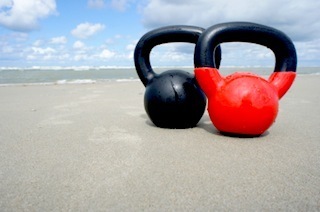 It’d be nice if regular activity was woven into our daily lives so that we could stay lean, strong, and fit without really thinking about it, but that’s not the world most of us live in. We have to set aside time to move our bodies. But, as I always say, this doesn’t mean we have to exercise atop a conveyor belt with a TV in front of it doing everything we can to forget that we’re even exercising in the first place. It doesn’t mean the workouts have to take an hour to complete. And it certainly doesn’t mean you need a gym to get in some good activity. That’s why I started writing the Workouts of the Week, a compendium of fun, effective, varied workouts for you to try. Readers still visit the archives to shake up their routines, so be sure to check them out if you’re in the market.
It’d be nice if regular activity was woven into our daily lives so that we could stay lean, strong, and fit without really thinking about it, but that’s not the world most of us live in. We have to set aside time to move our bodies. But, as I always say, this doesn’t mean we have to exercise atop a conveyor belt with a TV in front of it doing everything we can to forget that we’re even exercising in the first place. It doesn’t mean the workouts have to take an hour to complete. And it certainly doesn’t mean you need a gym to get in some good activity. That’s why I started writing the Workouts of the Week, a compendium of fun, effective, varied workouts for you to try. Readers still visit the archives to shake up their routines, so be sure to check them out if you’re in the market.
Today, I add ten additional fast but effective workouts to the list.
Max Reps Multiplied
Choose two movements – one upper body focused, one lower body focused – that are complementary and do not conflict with each other. Pullups and squats, good. Deadlifts and squats, not so good. For each movement, perform the maximum amount of consecutive reps you can do. Multiply that number by four to give you a target amount of total reps. You have ten minutes to reach the target rep count in each exercise using any set and rep scheme you desire. So if you were able to do eight pullups and six front squats in a row, you need to do 32 more pullups and 24 more front squats. For weighted movements, 50 reps (including your initial max set) is the upper limit. For bodyweight movements like air squats and pushups, the upper limit is 100 reps. If you reach the upper limit, add weight next time.
Baby Steps
Very few of us launched right into full-blown bipedalism out of the womb. Instead, we crawled, crawled, and crawled some more. Contrary to the popular belief that crawling is just a useless placeholder for walking, moving around on all fours develops shoulder mobility and strength and contralateral awareness, plus the basic ability to move around and explore the environment. Adults should crawl too. It’s a little different for us, though. We’re heavier than babies, so crawling can be taxing, particularly on the upper body. We’re also not used to crawling, so it’s a new movement all over again for many of us.
The easiest way to learn how to crawl correctly is to start on the hands and knees. Assume the position. Place your left hand/left knee close together and your right hand/right knee further from each other. “Step” forward with your left hand and right knee, then follow with the right hand and left knee. Continue in this contralateral fashion. You can certainly try to crawl ipsilaterally (right hand/right knee forward), but your movement will be suboptimal. Once you’re comfortable on your knees, move to the balls of your feet and hands.
For the workout, crawl for seven minutes out of the allotted ten. The three minutes of break time can be divided into as many break periods as you like (e.g. three 1-minute breaks, or ten 18-second breaks, etc.). Crawl forward, crawl backward, crawl uphill, crawl downhill. Crawl sideways. Just explore the environment from the vantage point of a big baby.
Short and Heavy
Rather than a description of Gimli son of Glóin, this is a prescription for heavy kettlebell swings and short sprints. Every minute on the minute, do ten swings with a weight that’s heavy for you and follow it immediately up with a short 5 second all-out sprint. Because the actual workout part of the workout will be short (but very intense), put every fiber of your being into the swinging and especially the sprinting. It doesn’t sound like much, but it will be after ten minutes.
If you don’t have a kettlebell, any weighted object that’s able to safely pass between your legs will work. Sandbag, weight plate, dumbbell, small child, etc.
The basic kettlebell swing is detailed in this video by Dan John. Watch it if you need to know how to perform the swing correctly. To switch things up from the standard swing, check out this video from Clifton Harski for some ideas on how to do it.
Park Play
Here in the United States, a single guy is liable to get the cops called if he so much as glances at a jungle gym set. Heck, most of the ones I see actually have signs explicitly forbidding childless adults from being there, so for this workout, you’re going to have to be covert about it. Stick to times when the playground is empty, partly for your security and partly so you don’t bowl over any kids during your workout. Or, bring a kid (hopefully your own) to join in with you.
The makeup of this workout depends on the equipment at your disposal. Most jungle gyms allow you to do some sort of pullup, so do some of those. If you can swing across from bar to bar, all the better. Climb poles, vault over barriers. Avoid taking the stairs and instead climb the structure itself. Crawl up slides, then slide back down and finish with a roll onto the ground. Just keep moving as if you’re a kid on a candy-fueled bender. Maybe there are some hot lava monsters afoot, too.
Spend ten minutes doing everything you can think of to move around on and interact with the playground equipment. Ten minutes is long enough to get a great workout but short enough to evade suspicion. For more ideas watch this, this, this, this and this Primal Blueprint Fitness videos.
Burpee Ladder
The burpee is a simple yet humbling exercise. You begin with a pushup – that’s easy enough, right? – and spring up to the bottom of a squat, then stand and jump as high as you can before repeating the movement pattern. The first seven or eight burpees are always pretty easy, because you’re so focused on doing the movement that you barely realize the amount of taxation your body is accumulating. Once you finish that first set, though, the realization that you’re in for a rough time sets in.
Do ten of these the first minute, nine the second, eight the third, and so on. The faster you perform the burpees, the more rest you’ll get until the next set. The slower you perform the burpees, the less rest you’ll need since the burpees will be easier. What do you choose? Where do you strike the balance between intensity and rest? That’s for you to find out.
Dig, Dug
For this one, you’ll need a couple pieces of equipment. First, a medium sized garbage can. Second, a bunch of sand, diggable dirt, or gravel (the beach would work nicely here). Third, a shovel.
Using the shovel (or your hands if you prefer), fill the can at least a quarter of the way for women and halfway full for men. Once the can is at the requisite fullness, squat down so that you’re straddling the can and wrap your arms around it. Pull the can toward you (bear-hug style), maintain proper neutral spine, and stand up with the can in your arms. Perform three sets of 5 squats. If the can isn’t full enough to be a challenge, add a bit more material in between sets. After the third set, spend the rest of the allotted ten minutes filling the can up the rest of the way.
Travel Rearrangement
I often find that traveling affords me unique and effective ways to exercise. Either the place I’m staying at has a great gym with all the equipment I’d ever need, or perhaps the location is such that outdoor activities are encouraged and unavoidable. But sometimes you end up in those joints with a few mismatched dumbbells, a broken elliptical trainer, and surrounding environs comprised entirely of strip malls and parking lots. When that’s the case, how’s a guy supposed to get a good workout in? Burpees in the bathroom and dips on the chairs are effective, but those get old fast.
Next time you’re stuck in a hotel room, antsy to work out, consider rearranging the furniture. I’m serious here. That old CRT TV that weighs a million pounds? Move it over to the opposite corner. The entertainment center? Slide it across the floor to the other side. Flip the sofa up and over, flip the mattress, lift the easy chair. Pull, push, slide, lift, carry, and heave furniture around. Do this for ten minutes and work up a great sweat. But of course, be careful. We wouldn’t want any damage charges added to your hotel bill.
Beach Sprints, Modified
If you haven’t seen my old beach sprint video, check it out now. The cool thing about sprinting on the beach is that it’s easier on the joints and yet harder on your muscles because you’re working with a softer, more forgiving surface that absorbs a lot of the impact. How about we take it a step further and move toward the surf?
For Beach Sprints, Modified, you’ll be sprinting through shin to knee deep water. Wade out to where the water is lapping at your thighs and run sprints up and down the beach. Do 30 seconds on, one minute off, until the ten minutes are up. Classic beach sprints are also a dependable staple, of course.
Cars
You’ll need a partner for this, partly to steer the car and partly because you’re going to need a rest. You’ll also need a car.
Choose a street or parking lot with a slight elevation. It shouldn’t be such that you have to turn your wheels toward the curb when parking. In fact, it should be barely perceptible to the naked eye.
Have your partner sit behind the wheel with the car in neutral, the engine off, and the parking break released. Get behind the back bumper, face the car, and push the car up the slight incline. I recommend around 20-30 yards depending on the weight/size of the car. Don’t sprint it so much as walk it. Think of this as a test of your strength rather than something to throw yourself blindly upon. It’ll be a grind. Take full steps and be sure to place your heel on the ground with each step. Take a minute to rest, then push the car back the other way, slightly downhill, only going twice the distance as the first run, and sprint. You’ll find you go about twice as fast going downhill. It’s a very different feeling than the grind-it-out sensation of the uphill push.
Switch places with your partner and try to get another round of pushing in before the ten minutes is up.
Try not to throw up. And again, be extremely careful when attempting this challenge.
Could You Carry Your Prepubescent Self?
Forgive the convoluted name, but it makes sense when you learn what the workout entails: carrying a weight equal to 1/3 to 1/2 your current bodyweight for a full ten minutes. Use a barbell loaded with the requisite weight, a heavy sandbag, or an actual prepubescent version of yourself. Carry it for ten minutes using any method desired; just don’t put the weight down. Carry it on one shoulder, or both. Carry it in the front rack position, or placed on your traps. It doesn’t matter, and variety is actually probably best.
While merely standing there might seem like the easiest way to reach ten minutes, from my experience you’ll end up focusing too much on the weight and get discouraged. Instead, try walking around. Be the crazy guy who walks around the neighborhood with a barbell. Walk around your yard. If you’re game, throw in a few lunges and presses while you’re at it. Just don’t drop the weight until the ten minutes have passed.
If you have a little more than ten minutes and access to the outdoors, might I recommend the Outdoor Stamina workout?
That’s it, guys. Hope you’re able to get some use out of these workouts. I definitely have.
What about you? What are your favorite ten minute go-to workouts?
Get the Primal Blueprint Fitness eBook, Free Health Tips and Primal Recipes Delivered to Your Inbox

March 19, 2013
How to Make Turkey Jerky (That’s Super Easy and Tastes Like Thanksgiving)
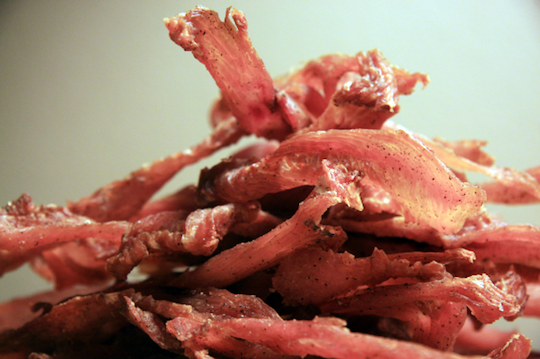 I’m pleased to have our friend David Maren of Tendergrass Farms pen today’s guest post. He’s written this great how-to for making your own delicious pastured turkey jerky. And don’t miss the coupon code that he’s generously provided below!
I’m pleased to have our friend David Maren of Tendergrass Farms pen today’s guest post. He’s written this great how-to for making your own delicious pastured turkey jerky. And don’t miss the coupon code that he’s generously provided below!
Most folks who make turkey jerky just make beef jerky out of turkey. They tend to use lots of teriyaki sauce, sugar, and Worcestershire sauce to mask the turkey-ness of the turkey. To each his own, but in my opinion this is a real shame. After all, turkey is super scrumptious! Especially if you go to the trouble of getting some good quality pastured turkey, you’ll want to preserve its essential turkey flavor as a special feature of your turkey jerky. We’ve discovered an extremely simple way to make delicious, high-protein, sugar-free, turkey jerky that will not only taste and look nothing like beef jerky, but will also magically transport you back to your childhood Thanksgiving dinner table. In fact, between you and me, I think it tastes a lot like buttery mashed potatoes and gravy. But no worries – it’s about as primal as primal can be.
This recipe is the very pinnacle of culinary simplicity. You’ll need:

Turkey breast, at least about 2 LBS (preferably from a good pastured turkey)
Salt and pepper
An oven (no fancy dehydrator necessary)
A few kabob skewers (or wooden chop sticks)
Nothin’ else!
It’ll take about 10 minutes of prep time and then the jerky will need to be in the oven for 6 to 10 hours (depending on your oven and how thinly you cut the turkey strips).

You should really think about supporting a family farmer by purchasing some decent pastured turkey breast to make your jerky with. EatWild.com has a helpful directory of grass-based farmers across the USA, Canada, and beyond that would love your support. If you can’t find any local pastured turkey sources our little cooperative online meats shop, Tendergrass Farms, offers pastured turkey breast that we can ship right to your doorstep.
In fact, in the spirit of family farm generosity, we’ve created a coupon code that’ll give you four (4) free jumbo boneless skinless roasts of our pastured turkey breast with all orders over $199 (a $99.96 value), which will also qualify your order for Free Shipping. Head over to the Tendergrass Farms site and once you’ve added $199 of our grass fed beef, pastured pork, pastured chicken, or pastured turkey to your cart, just view your cart and apply the coupon code FARMERS-RULE-123 and four 2 lb. pastured turkey breast roasts will be automatically added to your cart with a price of $0.00 (expires 9/30/13, limited to 150 redemptions). Pretty cool, huh? I guess we just figure what comes around goes around.
Tip: If $199 sounds like a big first order just grab a couple friends from the gym and place an order together.
Once you’ve procured some good turkey breast, the first step is to cut it into very thin slices. There’s no danger of cutting them too thin, so just get a nice sharp knife and cut the pieces as thinly as you can. It’s best to keep them as even in thickness as possible to help them dehydrate at the same rate.
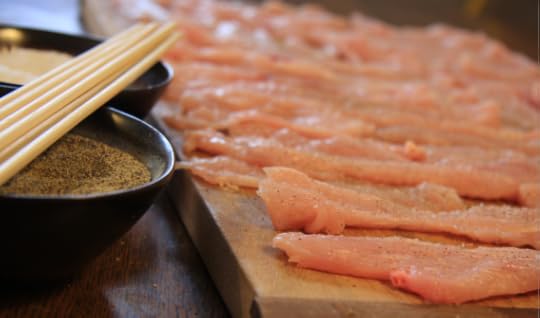
The second step is to sprinkle the turkey strips with a little salt and pepper. Salt and pepper the turkey just a little more than you would any other food that you were about to eat. The purpose of the salt and pepper is simply to bring out the natural flavor of the turkey, not to mummify it!

The third and final step is to skewer the strips of seasoned turkey with your kabob skewers (or wooden chop sticks) and hang the skewers from the upper rack of your oven. Just make sure than the strips are spaced out well to allow the strips to evenly dehydrate. Turn your oven on to 200 ºF, but don’t quite close your oven door. It works well to stick a nice big wooden spoon or other similar object in the door of the oven to allow just an inch or so opening for the humidity to escape from the oven as the turkey dehydrates.

Check on it periodically. At 200 ºF, with the oven slightly cracked open, it may take anywhere from 6 to 10 hours. This depends entirely on the thickness of your turkey strips and your particular oven, so it could be slightly shorter or longer depending on those factors. When the strips are completely hard to the touch with no hint of soft raw meat texture, your jerky’s done! It’s best to keep it in zip-top bags in the freezer, especially if you don’t think you’ll eat it all within a week or so.

David Maren is a husband, father, farmer, and co-founder of Tendergrass Farms . Tendergrass Farms is a cooperative online grass fed meats shop that exists as a bridge between the often geographically isolated family farmer and committed grass fed meats enthusiasts like yourself. The Tendergrass Farms vision is to sustain family farms through making it easy for you to purchase their meats by taking advantage of appropriate technology and ultra-efficient transportation models that enable their meats to be shipped to fans all around the USA.
If you’re not already a huge fan of Tendergrass Farms, you’re missing out: Go bookmark their site , like their Facebook page , and follow them on Twitter !

March 18, 2013
Dear Mark: Brain Caloric Expenditure, Muscle Preservation, Potassium, and Iron Supplements
 For today’s edition of Dear Mark, I’m covering four of your questions. First up is a question from Rachel, an English major who finds herself growing ravenous once exam time rolls around. I discuss whether or not her increased cognitive activity is increasing the amount of fuel her brain is burning through, and whether this affects her hunger. Next I provide a few tips to a young athlete who’s injured and has to rest, but doesn’t want to lose any muscle mass or curtail his fitness pursuits in the process. Luckily, there are a few dietary modifications he can make to preserve that lean mass. Third, I discuss the importance of potassium. It plays a few vital roles in the maintenance of our health, and if you want enough, you’ll have to consume some plants. Finally, I field a question from a woman who’s worried about iron supplementation. She’s not doing it, thinks she might need it, and wants my take on the subject. I explain why it’s probably better to get your iron from food, rather than supplements – which may do more harm than good.
For today’s edition of Dear Mark, I’m covering four of your questions. First up is a question from Rachel, an English major who finds herself growing ravenous once exam time rolls around. I discuss whether or not her increased cognitive activity is increasing the amount of fuel her brain is burning through, and whether this affects her hunger. Next I provide a few tips to a young athlete who’s injured and has to rest, but doesn’t want to lose any muscle mass or curtail his fitness pursuits in the process. Luckily, there are a few dietary modifications he can make to preserve that lean mass. Third, I discuss the importance of potassium. It plays a few vital roles in the maintenance of our health, and if you want enough, you’ll have to consume some plants. Finally, I field a question from a woman who’s worried about iron supplementation. She’s not doing it, thinks she might need it, and wants my take on the subject. I explain why it’s probably better to get your iron from food, rather than supplements – which may do more harm than good.
Let’s go.
I LOVE your site!!! I’ve been reading it for a while, but just made the change from a CW “healthy” diet to a primal one this past October and I’m NEVER looking back!
My question is this: I’m a college student, and I always get SUPER HUNGRY during exams. I’m an English major, so exam time actually usually means LESS stress and MORE sleep for me since papers and readings are finished. Does studying intensely actually increase your fuel demand?
Rachel
Our brains are incredible energy hogs, making up only 2% of our body mass while using up about 20% of the energy we take in. So during a period of heavy thinking, say, finals week, you’d expect the energy demands to increase and our overall caloric intake to follow. It seems like that should be the case, but the evidence is mixed:
In one study, subjects performing a verbal fluency test increased the cerebral glucose metabolic rate by 23% (for the duration of the test) compared to the resting control group. Subjects who did better on the test burned less glucose, probably because their brains were more efficient at performing the task. Oddly enough, this other study found that high aptitude subjects (people for whom the tasks were easier) used more glucose than lower aptitude subjects (people for whom the tasks were more difficult). Clearly, it’s not quite as simple as “hard task = more fuel required.”
Another study found that a period of “intense cognitive processing” led to measurably lower levels of blood glucose than a period of resting, indicating that actively using your brain burns more glucose than not using it. In one of my favorite books, Why Zebras Don’t Get Ulcers, Robert Sapolsky notes that top chess players engaged in intense competition often have metabolic requirements similar to top athletes during training.
Walking, which uses fuel, has been shown to improve cognition. And I don’t mean walking regularly makes you smarter through a training effect (although that’s also true!); I mean that walking improves your brain function immediately. If improving brain function were as simple as increasing glucose availability, this shouldn’t happen.
I’m not totally convinced that mental tasks have no effect on fuel consumption. I think part of it is that recreating the frantic mental atmosphere of finals week can’t really be replicated in a lab setting. One to two hour studies where subjects are being paid to memorize numbers or colors or perform “arduous” mental tasks just don’t measure up to the reality of studying as if your future depends on it (it probably doesn’t, but it sure does feel like it!) for a week straight. The Sapolsky mention of chess players’ metabolic demands lends credence to this.
There’s also the stress component. You say you’re not very stressed out because you’re getting plenty of sleep and don’t have to worry about papers, but studying for an exam – or multiple exams – is generally not a pleasant, enjoyable experience. Watching a gripping documentary or reading a great novel? It’s stimulating and requires brain activity, but it’s ultimately experienced as a pleasurable encounter, and you don’t leave the theater exhausted or the library starving. Scary movies, on the other hand, do increase caloric output, probably because they are slightly stressful. By definition, studying for the big exam is placing stress on your system, and the body responds by increasing cortisol, adrenaline, and turning on a bunch of physiological processes which burn through fuel reserves.
The point is that if studying is making you hungrier than normal, studying is increasing your fuel demand, whether it’s because of increased stress, increased metabolic demand by the brain, or both. Maybe you forgot to eat. Whatever the cause, you should probably eat.
Hi Mark,
I am an 18 year old male from Australia who regularly competes in middle-distance athletics (800-3000m) events, but recently rendered sedentary with a painful varicocele. In order to best maintain muscle mass and CV fitness should I up my fats, limit any carbohydrates, and up protein? What do you think are the most essential foods/drinks for fitness maintenance whilst completely inactive?
Thanks a lot,
Jonny
Sorry to hear it – that’s tough. I know how hard it is to sit out, and I have a few bits of advice:
When it comes to retaining lean body mass while on bed rest, protein is king. Try to get a gram of protein per pound of lean body mass.
You might also look into branched chain amino acids (BCAAs), which have been shown to attenuate the loss of lean body mass and protein wastage during bed rest.
Try not to restrict calories too much. Since you’ll be inactive, your needs will probably be lower, but dropping them even further will only speed up the catabolic process and cause you to lose even more lean mass.
Other than that, just keep eating nutrient-dense food. You probably won’t be as hungry as usual, so make sure you’re not “wasting” your calories on junk.
Unfortunately, there’s not much you can do to maintain your cardiovascular fitness while doing absolutely nothing. The good news, however, is twofold: keeping as much lean mass as possible and being a young guy will help you bounce back faster. You won’t lose much.
Dear Mark,
I’ve have begun to use FitDay to ensure I’m getting all my essential vitamins and minerals. It seems I’m consistently low in potassium (around 80% RDA). My diet consists entirely of meats, seafood, veggies (mostly raw), nuts, and berries (every other day). I’ve been cramming veggies to make up the imbalance. Is this what I should be doing? Perhaps the RDA is higher than I need on this diet? Or should I consider a supplement?
Thanks,
Mark in DC
That sounds like a solid, healthy diet, for the most part. However, if you’re coming up short on potassium, you probably want to take care of that. Potassium is a very important mineral, performing a range of functions in the body:
It regulates blood pressure, with some studies even showing that it’s more important in the fight against hypertension than sodium.
Potassium regulates the excretion of calcium in the urine, which is probably why its consumption is associated with high bone mineral density. More potassium, less bone in your pee. You don’t want to urinate bone, do you?
Humans also aren’t very good at preserving potassium in a state of deficiency, which indicates to me that we likely evolved in a dietary environment where potassium-rich plants were readily available. It also indicates that potassium is a crucial micronutrient.
Considerable evidence exists that it’s not the absolute amounts of potassium or sodium that are so important, but rather the potassium:sodium ratio – particularly in men. Track your sodium intake for a week. Shoot for around three to four times as much potassium as sodium, but preferably more than that. Bonus of eating more potassium? You can eat more salt without negatively affecting your blood pressure.
Besides the usual potassium-rich suspects (spinach, sweet potatoes/potatoes, avocados, bananas, most plant foods), dairy products like yogurt are surprisingly high in potassium. If you do dairy, consider adding a cup or two of dairy a day. Fresh meat also has potassium, but we end up cooking most of it out. Consume your meat on the rarer side, or toss it into stews and soups, and you’ll consume more potassium that way.
Should women eating a Primal Blueprint diet and taking your damage control supplements take additional iron supplementation?
Thank you for all you do!
S.
Probably not. Iron supplements have a generally poor track record, which is partially why I kept them out of my supplements. They have a history of exacerbating gastrointestinal distress, and, if you don’t actually have a need for supplementary iron, iron overload. Having too much iron is associated with atherosclerosis, cartilage degeneration, fatty liver, type 2 diabetes and a host of other maladies. Among anemic women, iron supplementation increases oxidative stress even as it corrects the anemia, making “blind supplementation” all the more dangerous.
Besides, there are so many easy ways to obtain iron from your diet, particularly one of the Primal variety. Eating meat, even one that isn’t particularly famous for its iron content like pork, is as good as or better than iron supplements at repleting iron stores with fewer side effects. Something like beef, lamb, or organ meats will be even better sources of iron (in addition to tons of other important micronutrients like zinc and vitamin A).
Before you worry about iron, figure out if you even have an iron issue. Get a full iron panel done, and be sure to test for ferritin (the storage form of iron). Only then should you explore actively increasing your iron intake, whether by food or supplementation.
Thanks for reading, guys. Take care and Grok on!
Grab The Primal Blueprint Cookbook Today and Receive Free S&H and a Free Primal Blueprint Poster

March 17, 2013
Weekend Link Love
 Registration for the 2013 Ancestral Health Symposium in Atlanta is now open to the general public. Check your schedule, move some things around if you have to, just get there because it’s going to be another amazing weekend.
Registration for the 2013 Ancestral Health Symposium in Atlanta is now open to the general public. Check your schedule, move some things around if you have to, just get there because it’s going to be another amazing weekend.
Big thanks to my buddy Flavio, who shot me for this article in Brazil’s largest newspaper. Flavio specializes in weddings in the SoCal area.
Research of the Week
How night owls are at greater risk for, well, pretty much everything.
Dogs are Primal, confirmed. The first domesticated dog was around at least 33,000 years ago.
In rats, intense sweetness hits the reward center of the brain harder than medical-grade cocaine.
Another study fails to find an association between meat (even the processed stuff) and mortality. I eagerly await the torrential flood of articles reporting the results.
Interesting Blog Posts
We all hear how important it is to shut out the chatter and be in the here and now. Here’s how to actually go about doing it.
Do paleo or ancestral diets cause gout? Chris Kresser explores the topic. (Short answer: no).
Media, Schmedia
Here’s the video every vegan (and heck, every person who’s ever looked down their nose at someone for the effect of “all that meat eating” on the environment) needs to watch. Twice.
Take a moment to watch the first 13 minutes of the upcoming documentary Statin Nation: The Great Cholesterol Cover-up.
Everything Else
The physics of the pullup (plus, why women can do them).
How the pharmaceutical industry affects the environment, and why you should dispose of pharmaceuticals properly (my particular favorite method is never needing them in the first place).
Recipe Corner
Remember Nacho Rubio? He’s back, in vlog form!
A fusion of Western and Eastern tradition: chai-infused marble Easter eggs.
Time Capsule
One year ago (Mar 17 – Mar 23)
Detaching Yourself From the Outcome – Outcomes are nice and all when they go your way, but things get a whole lot more pleasant when you stop worrying about them so much.
12 Tools That Can Help You Achieve Your Health and Fitness Goals – Check out these online tools to help you get to where you need and want to be – health and fitness-wise.
Comment of the Week
“I’m pretty sure white bread buns, strange goopy seed oil sauces, and french fries all play their role, too.” – don’t forget the tomato jam!!
that’s my personal pet peeve.
- “Tomato jam.” I like it! I think I’ll have to start using that one.
Get All Three Primal Cookbooks, an Apron and More in The Primal Blueprint Chef Kit Today!

March 16, 2013
Chicken in Buttery Caper Sauce
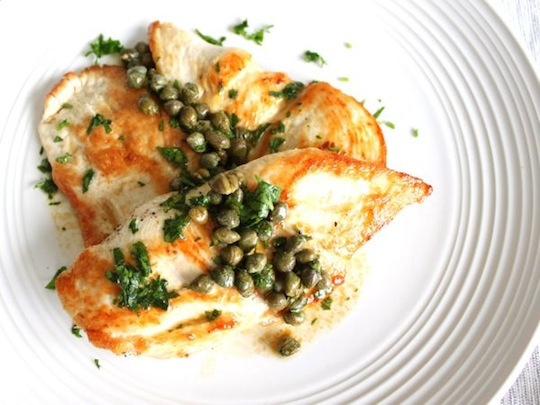 The star of this recipe is a simple sauce with bold, memorable flavor. Three easy ingredients – capers, parsley, butter – plus one secret ingredient (the brine from the caper jar) come together into a rich and piquant sauce that will have you licking the plate.
The star of this recipe is a simple sauce with bold, memorable flavor. Three easy ingredients – capers, parsley, butter – plus one secret ingredient (the brine from the caper jar) come together into a rich and piquant sauce that will have you licking the plate.
The caper sauce pairs really well with chicken; in this case, boneless, skinless breasts pounded thin to reduce the cooking time to just 6 minutes. However, if you have a little more time on your hands the sauce can certainly be served with thicker skin-on breasts or thighs, a pork chop or tenderloin, a pan-seared fillet of fish or roasted vegetables.
Tiny, briny capers are actually flower buds that have been sun-dried and pickled in vinegar. The tart, lemony flavor of capers adds a bright, tangy boost to food. Keep a jar in the fridge (they never really seem to go bad) to throw into other dishes or to make this fantastic sauce whenever the mood strikes.
Serves: 4
Time in the Kitchen: 30 minutes
Ingredients:
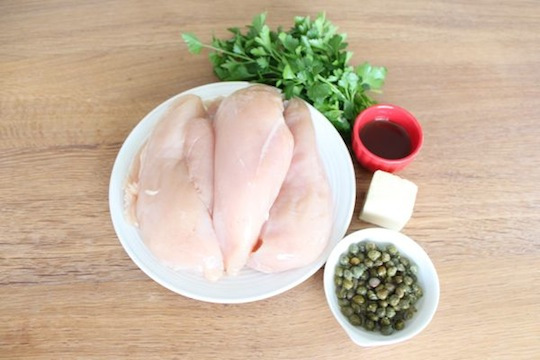
4 boneless, skinless chicken breasts
4 tablespoons olive oil (60ml)
3 tablespoons of capers, plus 3 tablespoons of brine from the jar (45 ml)
3 tablespoons unsalted butter (60 g)
1/3 cup finely chopped parsley (80 ml)
Salt and pepper
Instructions:
Slice each chicken breast in half horizontally. Place each half between sheets of plastic wrap and pound with a meat mallet (or small skillet) until 1/4 inch (6 mm) thick or less.
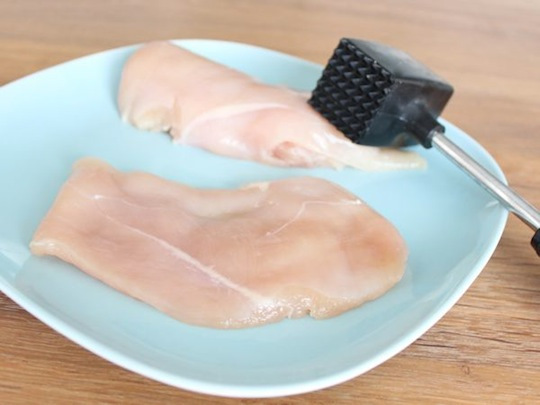
Generously season chicken with salt and pepper.
In a large skillet heat 2 tablespoons (30 ml) of olive oil. Add half of the chicken and cook for 3 minutes on each side until nicely browned. Remove the chicken from the skillet and set aside on a plate.
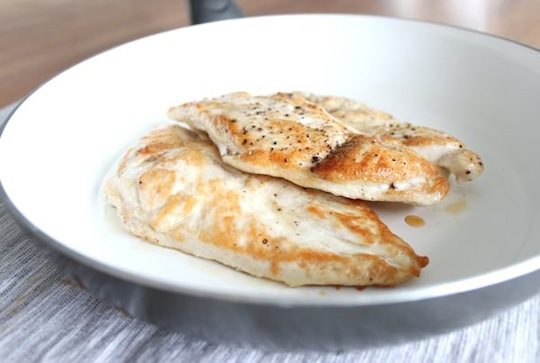
Heat 2 more tablespoons of olive oil. Add the remaining raw chicken and brown for 3 minutes on each side.
Remove the chicken from the pan, adding it to the plate of cooked chicken, but keep the heat on under the skillet.
To the skillet, add 3 tablespoons of brine from the jar of capers.
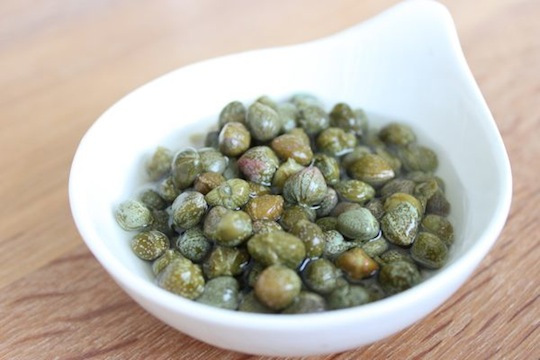
As the brine boils, scrape up any bits of meat stuck to the pan.
Stir in the butter, parsley and capers. Just before the butter begins to brown, add the chicken and any juices that have accumulated on the plate back to the skillet. Keep the chicken in the skillet just long enough to re-heat it and coat the breasts in sauce.
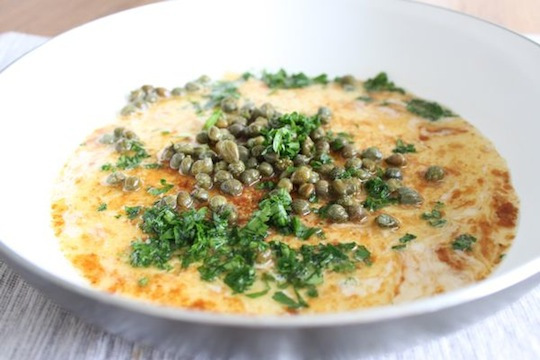
Serve immediately.
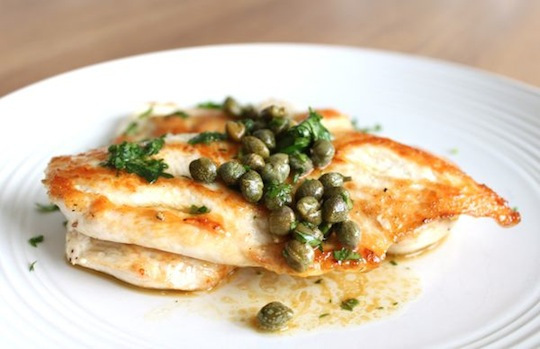
Get All Three Primal Cookbooks, an Apron and More in The Primal Blueprint Chef Kit Today!

March 15, 2013
It Will Pass and I Will Be Stronger
It’s Friday, everyone! And that means another Primal Blueprint Real Life Story from a Mark’s Daily Apple reader. If you have your own success story and would like to share it with me and the Mark’s Daily Apple community please contact me here. I’ll continue to publish these each Friday as long as they keep coming in. Thank you for reading!
 Dear Mark,
Dear Mark,
I have been completely Primal for just over a year, and working towards that for almost three years. It has changed my life from feeling like I was living in an unlit and windowless room, to really participating in life and finding fulfillment. It’s been that dramatic.
I was an active, healthy kid with a good diet until I was twelve. My home life became very unstable. I was moved around a lot, and lived with several different relatives and attended different schools. It was hard on me. I was a very introverted kid to begin with, and I didn’t make friends. I read books and did homework and ate. I quickly became very sedentary, and very sad, and I had access to a lot of processed, sugary foods that my mother had never kept in my childhood home. I was given a lot of autonomy over my diet, and I quickly became addicted to these foods.

By the time I was 16, I weighed 240 lbs at 5’7″ and I was extremely depressed, bulimic and very unhealthy, with bad skin. That was the year I was also diagnosed with PCOS, an explanation for my painful, irregular periods and other symptoms. I tried to lose weight by restricting calories, but when I was depressed I would care less about my long-term health than my need for something comforting to eat. So I would binge, and feel guilty, and purge, and my bulimia got worse.

By the time I was 18 and living on my own, I was very sick. I was binging and purging more or less all day long, sometimes close to ten times a day. I remember feeling very scared the first time I threw up and had blood start pouring like water from my nose. I was more scared to stop throwing up, though. I wasn’t having periods at all, but occasionally I would go to the bathroom and find that there was nothing but blood in the toilet. That scared me, too.
When I was 20, living alone and in college, my depression and bulimia continued, and I also started drinking, alone, most nights. The nights I didn’t drink alcohol, I would do other drugs. I also started smoking. Once I was intoxicated, I would go out for a walk, alone, in my very bad neighborhood at three in the morning. I would occasionally get bursts of energy, and in one such burst, I got a new roommate, a new job, and I joined a community group. Then I was assaulted by someone I thought was my friend. I felt like my depression was a black hole sucking me in, that my life would just feel worse and worse until I died. I wanted so badly to die, but I was afraid to kill myself. I was hoping, I think, that the world would take care of it for me.
When I was 22, I had another one of these moments when my depression lifted. I bought a gym membership this time. I started going all the time, I would use the gym sometimes, and run on the treadmill. I wanted to know what to do at the gym, so I was looking at lots of online resources. I found nerdfitness.com, and through them, I found Mark’s Daily Apple. I remembered that a customer at my old job had, a couple of times, mentioned that he ate a caveman diet, but I hadn’t cared to look into it at the time.
When I did read about eating like a caveman, it resonated with me. I had started learning how to cook, and I was enjoying it, so the idea of a diet made of whole, unprocessed ingredients appealed to the chef in me. I love reading about science, so the more I read, the more it appealed to me, and the more Primal principles I started to apply to my own life.
I found that not counting calories and not throwing up was nerve-wracking. I gained weight at first, started purging again. I stopped weighing myself. The better my diet gets, the less I get an urge to binge. With no binging, I don’t purge. I slip up once in a while, but those incidents are getting further and further apart. I also got a physical job that I love: working in the produce department at the grocery store. I lost a lot of weight. My high weight was around 290 lbs, and now I weigh between 155 and 165 lbs.

My depression started to lift even more after I eliminated grains and sugar from my diet. Within 3 months I could feel a major shift. I no longer had long periods of apathy and hopelessness interrupted by the occasional “good month.” I now feel very calm and still inside. I feel tethered, and even when I do get sad (because it’s got to rain sometimes), it no longer feels like I’m getting sucked into a black hole of depression. It will pass, and I’ll be stronger.
I am stronger. I get stronger all the time, and calmer, and happier. That’s what keeps me doing this caveman gig. I’m so strong, in fact, that this spring I’m leaving on an adventure, I’m going to walk across the USA, from my home on Vancouver Island, to my parents’ home in Connecticut!
Thank you for giving me the tools I needed to save myself.

Lindsey
Grab a Copy of The Primal Connection: Follow Your Genetic Blueprint to Health and Happiness Today!

March 14, 2013
How Simplifying Your Life Can Help You Refocus on What’s Important
 Earlier this week I ran across a study that demonstrated a “simple lifestyle” can decrease our contact with toxic endocrine disrupting chemicals. The researchers looked at lifestyle elements like transportation, personal care products, and homegrown versus purchased food in their participants. I was struck by the study’s suggestion itself but also by the larger metaphoric significance. A simpler code of life can spare us some of the inherent stress and damage of our modern lives. As this study showed, the principle certainly holds for physical health, and I easily venture it holds for mental well-being, too. Living simply offers a multi-layered protective benefit. That’s worth taking apart.
Earlier this week I ran across a study that demonstrated a “simple lifestyle” can decrease our contact with toxic endocrine disrupting chemicals. The researchers looked at lifestyle elements like transportation, personal care products, and homegrown versus purchased food in their participants. I was struck by the study’s suggestion itself but also by the larger metaphoric significance. A simpler code of life can spare us some of the inherent stress and damage of our modern lives. As this study showed, the principle certainly holds for physical health, and I easily venture it holds for mental well-being, too. Living simply offers a multi-layered protective benefit. That’s worth taking apart.
The heart of The Primal Blueprint, as broadly applicable as it is for many people, is pretty simple, but I wonder how and when it inspires simplicity itself. We simplify our food by choosing fresh options based on what our ancestors ate for tens of thousands of years. We simplify our fitness by letting go of the need to follow every “latest and greatest, end-all” fad and just adopt some easy Primal movement principles. We simplify our priorities by putting a premium on sleep, outdoor time, and social connections. In many ways, it’s kind of about getting back to basics – ancestral style.
We do all this, of course, while we live in a culture that loves to complicate. In fact, we moderns have an uncanny way of making life difficult for ourselves. We stay up late, eat crap, guzzle caffeine, and wonder why we crash and recover multiple times a day. We surround ourselves with so many “things,” the clutter impairs our own ability to focus.
We’re strivers, analyzers, and accumulators but wonder why we burn ourselves and our relationships out on stress, self-chatter, and anxiety. Most of us have so much – much more than the majority of the world at least (and more than our primal ancestors ever dreamed of), yet we live with a misplaced sense of deprivation. Too often, we neglect or undervalue what we need (e.g. time to foster close relationships, time in the sun, time to sleep) but elevate aspects of life that are tangential at best. We give our positions and possessions more power than they deserve in the grand scheme of life – let alone human history.
It’s true of how we experience our own lives and how we look at others’. In our culture, we tend to attach status, even maturity and identity to the elaborateness of a home, vehicle, or outfit. Some of us overwork ourselves for a nice house we barely get to enjoy. Others forgo a vacation but spend money on collections that could easily pay for time away. Too often, we accumulate instead of experience. How much sense would any of this make to our ancestors? We’re stuck circling in a cul-de-sac of our own making. This would be the time to abandon the car and just trample through the manicured yards to get out of dodge.
Of course, it’s all about coming back to yourself. The freedom comes, I think, in identifying your core interests and values and centering your life around them. Although I’m not one for austerity, I think there’s something to simplicity – the mental, logistical, and physical spareness that brings a few key priorities into focus. If you can avoid the literal and figurative toxins of modern life while you’re doing it, all the better.
Ultimately, I don’t think it’s about formulas or absolutes or right answers. Everyone’s different. I think simplicity is about proportion – about aspects of our lives finding their “right” size in respect to everything else. In assessing these proportions, we recognize the influence each choice has on another as well as the impact of action on mentality. Researchers at the University of New Hampshire and Yale University, for example, found that those who felt less loved and accepted within relationships rated material possessions as more monetarily valuable. Underscoring this study, the researchers explain, is the source of our security and comfort. It’s worth asking, with what or whom do we situate our sense of personal security and comfort? Do our life choices and investments of time and energy appear to follow these priorities?
When I think about how I’ve changed over the last several years, I come back to that question. Although I’ve never been a complicated, high maintenance guy, I know I’ve changed as I’ve defined living Primally. These days I wear pretty much the same shoes – my Vibrams – wherever I go. I don’t think I’ve ever given much thought to clothes, and that’s certainly true now. I eat more or less the same thing for lunch each day. I like to work from home to avoid the hassle of traffic. Unless I have to be on the road for work, I pretty much follow the same schedule with some room for a spontaneous hike in the hills near my home or dinner with friends. I’ve never considered myself an accumulator of things or gadgets, and that remains true today. Maybe it’s in part the journey of later adulthood, but I know at this point what I like and what I need. I’ve decided what matters to me and what doesn’t. For example, I enjoy good food and a comfortable bed. I love to travel (sometimes) and then simply being home for long stretches where I can be with family and spend time in the ocean. When it comes to my personal life, these are the things in which I invest my time, resources, and attention.
At the end of the day, I think we embrace simplicity when we pare down our lives to a point at which we’re not overwhelmed or diverted by our inputs – our stuff, our choices, our responsibilities, or our aspirations. “More of everything!” seems to be a chant distinctive of our modern age. Although ambition and even a degree of materialistic interest might be part of human nature, gone are the traditional codes that kept those in check. People too often mistake this for inevitable progress and justification. When you take the original context away, however, natural impulses end up not making sense. Living Primally, I think, is about living conscious and respectful of that original context, however we choose to envision it at work in our personal health and life journey.
Thanks for reading today, everyone. Let me know your thoughts on living simply and how the Primal Blueprint illuminates or contributes to that motivation. Have a great end to the week.
Grab a Copy of The Primal Connection: Follow Your Genetic Blueprint to Health and Happiness Today!

March 13, 2013
Why Humans Like Taking the Easy Way Out
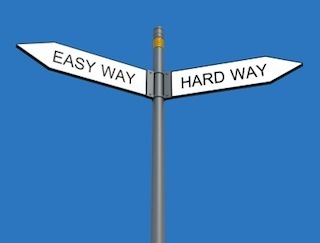 We fetishize hard work a bit, don’t we?
We fetishize hard work a bit, don’t we?
Toil, endless toil; gritty determination in the face of adversity; and ceaseless, relationship-rending labor are virtues to be praised. We applaud each other for working late, snicker at those who don’t, and measure our self-worth in timestamps. Meanwhile, those who “take the easy way out” are ridiculed and lambasted and passed over for promotions. Googling the term returns pages and pages of blogs explaining how to kick the habit of taking it easy. By all accounts, taking the easy way out seems harmful and counterproductive to our survival in this world. Why, then, do so many of us seem drawn to the path of least resistance? If “the hard route” leads to riches, why isn’t seeking it hard-wired in us all? Why do we tend to look for the easy way out of a situation?
Well, it’s just easier that way, for one. Physics says that the path of least resistance is generally the one taken.
Think about the evolutionary context, too – the context(s) under which we lived, evolved, adapted, and figured out how to survive. Like any other animal living in nature, we had to conserve energy when we could, because a grocery store wasn’t always right around the corner. We liked shortcuts, because those were more efficient and they used less energy and fewer resources. Toolmaking? Tools make tasks easier. An average 4-hour workday with plenty of downtime for leisure activities? That’s the easy way out. Persistence hunting? Easy way out. It just so happens that in the ancestral context, the “easy way” worked. Using persistence hunting as an example, this allowed hunters to bag an animal without burning through all their glycogen and electrolyte stores. Whereas attempting to run the animal down at a blistering-5 minute mile marathon pace would lead to pulled muscles, strained ligaments, exhausted glycogen stores, dehydration, and near-certain failure, the “easy way out” was also the most effective way forward.
Today, the situation is different. You’re not going to die (today) because you overextended yourself at work. You might be stressed out and sleep-deprived, but you’ll still have that car waiting in the garage to take you home to your refrigerator full of food and warm bed. You can overextend yourself and reap great financial rewards with minimal immediate risk to your personal safety. Survival is no longer about digging up some tubers, killing game, finding water, and avoiding the elements. Most of us have to figure out ways to obtain the slips of paper that are redeemable for goods and services, and that can take some hard, weird work. We’re paying for college tuitions, housing, transportation, smartphone data plans, vacations.
Population dynamics have changed, too. No longer are we drawing upon fertile, untouched grounds teeming with edible life and resources without much competition from others. Now we’re applying for jobs with hundreds of other applicants, or trying to make our products/businesses stand out amidst the burgeoning crowd. We stand alone as individuals against everyone else (or at least it can feel like that). The easy way out doesn’t work quite as well as it once did.
Yet the urge remains in many of us. I can relate. I grew up taking the easy way out as often as I could. Instead of walking to school, I ran. It was faster, it was more enjoyable, and it was just easier than trudging along. I’d take short cuts through wooded areas, again because it was faster, more enjoyable, and easier. When figuring out what sport to take up, I chose the easier route. Instead of working on my handle, lateral quickness, outside shot, and passing ability to overcome my size and excel at basketball, I went with cross country because it was something I was already good at. This continued in college and, really, throughout my life. I’d often choose to run fifteen miles to prep for a race instead of study extra hard for the exam because, well, running was “easier.” I coasted through with solid B’s because, well, it was good enough for what I wanted to do and because I had decided to postpone med school. All these shortcuts made sense to me, and they worked for me.
Later, when I realized that my training schedule was impeding my health and that I could improve my physique and overall fitness with less training and less endurance work, I jumped on it. I made my short, hard workouts shorter and more intense and my long, easy workouts longer and easier. Lifting weights was hard work, but packing it in to a smaller time frame somehow felt easier. Going for runs or cycling at a moderately high intensity for upwards of an hour was hard and fairly unpleasant, while extending the time and reducing the intensity was more enjoyable. It became a hike, a leisure activity. I was taking the easy way out with my workouts and getting better results.
I even designed my entire eating philosophy around taking the path of least resistance – spontaneous reduction in hunger instead of calorie counting, food quality instead of quantity, avoiding the problematic foods instead of soaking/sprouting/fermenting to make them less problematic – to get the best results. So there’s definitely still a place for taking the easy way out.
It’s really only in the business world that I’ve opted not to take the easy way out. I’ve had to put in the time, the hours, the grunt work to really excel and help build the Primal community from the ground up. Even though this venture has been a huge success, there are also drawbacks. I don’t have as much free time as I might prefer. I have to deal with ample amounts of stress. Even then, my decision to take the hard route and build this business was ultimately about improving my quality of life (and that of others, I hope!) and making it easier to do what I wanted to do.
And that’s the thing: sometimes shortcuts work, sometimes they fall short. Sometimes it makes sense to take the easy way, sometimes it doesn’t. Being drawn to the easy route isn’t a fault, it’s a built-in feature from long ago that doesn’t always work so well today. It doesn’t make us weak, though, and it’s not always a mistake to listen to that urge. You just have to be selective in choosing when and where to listen depending on the situation.
Overall, I think our preference for the easy route is a good thing, because it leads to shortcuts and improved efficiency – even if we have to work really hard for awhile to get there. So while the guys at the startup putting in 20 hour days are absolutely not taking the easy way out, their ultimate goal is to streamline the business so that things are easier and more efficient later. The woman who walks an hour every day instead of driving everywhere isn’t taking the easy route, but in forty years she’ll be the one playing with her grandkids, walking up stairs without an issue, and having an overall easier life than the person who opted to drive everywhere and never exercise. In the grand scheme of things, all these people who worked hard did so to relax and enjoy things later on.
We all want to take the easy route, even if we have to take a more difficult, roundabout way to get there.
As long as you’re aware of the evolutionary underpinnings of our urge to take the easy way out and selective in your response to that urge, you should be okay. Work hard and take risks where appropriate, take shortcuts when they work without shortchanging the final result. At any rate, blanket statements like “avoid the easy way out” aren’t very helpful, and they can even get you into trouble.
What about you? How have you taken the easy way out in life? When has it ruined you? When has it paid off?
Get All Three Primal Cookbooks, an Apron and More in The Primal Blueprint Chef Kit Today!

March 12, 2013
Is It Primal? – Pork Rinds, Cottage Cheese, Monk Fruit Sweetener, and Other Foods Scrutinized
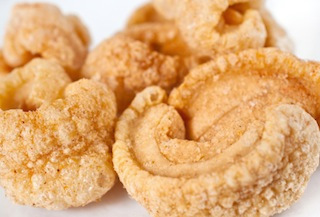 It’s time for another edition of “Is It Primal?” Before I begin, though, I want to reiterate that these are just my general recommendations. People ask for my opinion on various foods, and I provide them with an answer. It’s tough and nigh impossible to delineate Primal or not Primal in black and white terms, simply because the suitability of a food depends not only on the composition of that food, but also the context of the person who’s (considering) eating it. I’ll give you the basics, I’ll give you my opinion, and you have to determine the specifics. Sound good? And hey, don’t throw out your expensive electronics after reading this post.
It’s time for another edition of “Is It Primal?” Before I begin, though, I want to reiterate that these are just my general recommendations. People ask for my opinion on various foods, and I provide them with an answer. It’s tough and nigh impossible to delineate Primal or not Primal in black and white terms, simply because the suitability of a food depends not only on the composition of that food, but also the context of the person who’s (considering) eating it. I’ll give you the basics, I’ll give you my opinion, and you have to determine the specifics. Sound good? And hey, don’t throw out your expensive electronics after reading this post.
Anyway, today we’re discussing pork rinds, cottage cheese, monk fruit sweetener, sago, and black elderberry syrup. Let’s get to it.
Pork Rinds
Pork rinds have a long and storied history in every pig-eating country. Walk any major Latin American city and you’ll probably come across someone hawking chicharrones. In Canada, they’re scrunchions. In the US, they’re cracklings (usually pronounced “cracklins”). In Britain, they’re pork scratchings. Most Asian countries also have their own form. Wherever you are, though, the pork rind is essentially the same save for whatever seasonings were applied: slices of the skin fried in its own fat as it renders out.
The resultant fatty styrofoam-esque puffs are ubiquitous at mini-marts, truck stops, and ethnic supermarkets. They’re a rich source of protein, but it’s “unusable” and “useless” gelatin that won’t get you “hooge” or “anabolic” due to a lack of essential amino acids (if you listen to most fitness forums). That’s a simplistic way of looking at protein, as I’ve said before. Gelatin is rich in glycine, improves sleep, helps with joint pain, and can actually be protein-sparing. Most of us aren’t eating enough of the whole animal anymore, so the occasional handful of pork rinds can be an easy way to get your gelatin (though I’d say real bone broth, gelatinous cuts of meat like shanks, and even plain gelatin are arguably superior sources).
If you’re worried about seed oils being used as the frying medium, just check the label. You want “pork skin” and “salt,” ideally. If oils were used, they’ll be listed in the ingredients. This is pretty rare, though, as frying a piece of fatty skin in exogenous fat, instead of using the fat inherent to the skin, only costs the producer more money. MSG is often added, too, so watch out for that if you’re sensitive and wish to avoid it.
Some people crush them up and use them as breading for fried meat dishes. You probably don’t want to make this a regular thing, but it’s a nice alternative to standard breading.
The one thing I’m still wondering after all this: why do I keep misspelling “pork” as “prok”?
Verdict: Primal, as long as they’re cooked in their own fat.
Cottage Cheese
Historically, cottage cheese was made from the skim milk left over after butter making. The resulting product was a salty, low-whey, high-casein source of dairy protein rich in branched chain amino acids.
Since it’s mostly casein, people who react poorly to casein will probably want to avoid cottage cheese, too. And then there’s the talk of A1 casein v A2 casein, with the latter being the safer, more “ancestral” type that’s prevalent in Jersey cows (and buffalo, goats, and sheep) and the former being the dangerous, more “novel” type that’s prevalent in Holsteins and other modern breeds. I’m not sure I buy into the essential importance of it for everyone, but it’s something to consider if you think you’re intolerant of dairy in general (because it might be the A1 casein, not the “dairy”). Unless you make it yourself, though, I doubt there’s much A2-only cottage cheese available on the market.
Some of the higher fat cottage cheeses I’ve seen add various thickeners, binders, and emulsifiers, but if that’s an issue for you, a splash of heavy cream in the cottage cheese is a nice way to get around it and add some fat if you like. Blueberries make it even better. Or you can do it like they did in the old days and just eat some butter along with your low fat cottage cheese.
Verdict: Primal, if you do dairy.
Monk Fruit Sweetener
Deep in the forests of Guangxi, shrouded by mountain mists and tended to by mystical centenarians, grows the monk fruit. Its persistent vines studded with heart-shaped leaves curl around whatever they touch, and legend has it that the monk fruit vine sustains its caretakers by enveloping them and transmitting pure life-force directly into their hearts. What about the rest of us? Those who aren’t lucky enough to have a symbiotic relationship with a magical vine? Can we get anything of use from the monk fruit vine?
Maybe. The monk fruit itself appears to have some interesting components, similar to stevia, including a group of triterpene glycosides (called mogrosides) that are sweet but non-caloric. Like stevia, monk fruit mogrosides have some health effects beyond just being sweet without being caloric:
Monk fruit mogrosides have antioxidant activity,
In a mouse model of diabetes, mogrosides lowered oxidative stress, blood glucose, and improved blood lipids.
I’d say it’s worth a shot if you’re looking for a non-caloric, natural sweetener, especially if you don’t like the taste of stevia. Seeing as how one study gave dogs up to 3 grams per kg body weight without affecting body weight, food consumption, hematology, blood chemistry, urinalysis, organ weight, or histopathology, the monk fruit extract appears to be fairly non-toxic. And if you have the climate to grow monk fruit, you might try setting up that whole symbiotic relationship/lifeforce exchange thing (perfect for people who telecommute).
Verdict: Primal, especially if you’re okay with stevia.
Sago
Sago is palm starch, derived from young palm trees. It’s that stuff you often see people on the nature channel pounding into oblivion in order to render it into a somewhat edible powder. For folks who can’t just waltz into a Whole Foods and buy fresh meat, fruit, and vegetables or whose traditional hunting and foraging grounds have been severely marginalized by corrupt government officials and the large corporations who line their pockets, sago provides a valuable source of carbohydrate calories. Palms can grow where other food crops often cannot, so it’s undoubtedly better than nothing.
The problem is that carbohydrate is basically all sago provides. There’s essentially no protein, even less fat, and almost no micro-nutrition (save for a few measly milligrams of calcium and a little over one milligram of iron). Unless you have no other options, if you’re looking for starch, just eat some tubers. If you have the chance to try a traditional dish that uses sago, like the Malaysian fish sausage known as kerepok lekor, go for it. Just don’t rely on sago unless you have to, especially when plenty of more nutrient-dense starch and carb sources abound.
Verdict: Primal, but probably not worth your time.
Black Elderberry Syrup
I’ve always liked the sound of black elderberry syrup, probably because it sounds like something Bilbo Baggins would pour over his seed cakes. Actual elderberries are slightly toxic, in fact. The seeds, leaves, and twigs of the plant contain glycosides that convert to cyanide in the body, while the fruit flesh itself has other toxic components that must be nullified with heat. That’s probably why elderberries aren’t sold in bins along with blueberries and blackberries, instead generally being found in heated, concentrated syrup form in the health food aisle.
Elderberries do have potential as health boons. Like any other colorful berry, they are extremely rich in polyphenols, for one, and these elderberry plant compounds have been shown to inhibit osteoporosis in a diabetic mouse model and reduce lipid oxidation and oxidative stress. But you can say the same about polyphenols from other colorful plants. Anything unique to the elderberry syrup itself?
I think so. Traditionally, elderberries and their syrups were used as immune assistants. And, as is often the case, modern research appears to confirm some of the older justifications for use of the substance. For instance, it’s been shown to improve resistance against the flu virus. In vitro research shows that elderberry extract is deadly against pathogenic upper-respiratory bacteria (cold) and influenza (flu), and that elderberry flavonoids bind to and prevent swine flu infection. That said, a 2010 meta-analysis found that while the efficacy of elderberry extracts and syrups was “promising,” further research is needed.
As for the syrup part of “black elderberry syrup,” I wouldn’t worry too much. It’s sugary, but you’re not pouring this stuff over pancakes. It’s medicinal. You’re taking a teaspoon at a time, maybe a bit more or a bit less, depending on what the label recommends. At most, you’re getting five grams of sugar, which isn’t anything to worry about.
Verdict: Primal and perhaps quite useful in times of (minor) sickness. Just don’t pour it over pancakes (seed cakes from the Shire are acceptable, however).
That’s it for today, folks. If you’ve got questions about other foods, don’t hesitate to write in or leave a comment. Thanks for reading!
Get All Three Primal Cookbooks, an Apron and More in The Primal Blueprint Chef Kit Today!

March 11, 2013
Dear Mark: Is Meat Going to Kill Me (Again)?
 There’s another “meat is bad” study making the rounds, featuring such stellar prose as:
There’s another “meat is bad” study making the rounds, featuring such stellar prose as:
“Although causality cannot be established…”
“…further research is recommended.”
“…should still strive to reduce intake of red and processed meat, which tend to contain high amounts of saturated fat and sodium.”
And so on.
By now, we see these lines, roll our eyes, and keep on moving down the path that seems to be helping us. But that’s us, people who pay attention to nutrition news and stay abreast of the literature. We may be able to write off these breathless articles without thinking we’re going to die because we ate that bunless burger the other day, but our parents, our friends, our colleagues may not be so well-equipped. They’re worried about our health, and who can blame them? If you take mainstream health articles at face value, articles which confirm what your doctor is probably telling you, you would do the same.
Hi Mark,
Have you heard about the latest study saying that we’re all killing ourselves? I’m personally not that worried, but I’ve been getting a ton of frantic and/or smug emails from concerned and/or smug friends and loved ones. I’d love to be able to point them toward something to explain the results. Think you could tackle it?
Thanks,
Matt
This is another in a long line of observational studies that find associations between processed meat intake and early death so that journalists can feel superior about something while writing easy articles (with lots of copy and pasting from the last one). I mean, aren’t they all the same? “Regardless, [name of expert] is quick to urge consumers to cut back on [delicious, Primal food that has supposedly been killing us humans, bite by bite, for tens of thousands of years] and reduce the overall percentage of [saturated fat or cholesterol or sodium] in their diets.” If you’ve read one, you’ve read ‘em all.
I feel like I’ve done all this before. I’m experiencing the distinct sensation of deja vu, kinda like when you have a dream and it feels like you’ve had it before, but when you wake up and try to piece it all together with a clearer mind, you realize that it was a totally unique vision and just an artifact of the nature of dreamscape. This may not involve showing up late to the big exam in the nude or falling from a cliff and waking up right before you hit ground, but it’s strangely familiar, isn’t it?
Being hit with one of these studies every couple months like clockwork wears down a man. It boggles me how people can grapple with the same questions (oftentimes using the same datasets), never coming to a conclusion, never even getting any closer to the truth, always dancing around on the edges. I get that this is how science works – you can’t leap to conclusions that aren’t actually there – but why not ask some different questions? It’s the same thing over and over again.
And yet it will be thrown in your face, so let’s go over it.
The study used data from the European Prospective Investigation into Cancer and Nutrition (EPIC) study, which collected complete information on diet, smoking status, physical activity, and BMI from almost a half million men and women without stroke, cancer, or heart disease. They grabbed a decade’s worth of data along with “clinical endpoints” (death from various causes), and have since been running the numbers to see the effect of various factors – usually a particular category of food or nutrient – on mortality. Today’s study was about the effect of red meat and processed meat on all-cause mortality.
What did they find?
The highest intake of processed meat was associated with a 44% increase in all-cause mortality. That could be death from bladder cancer, myocardial infarction, or car accident. Anything goes. This association was reduced to 24% after adjusting for smoking, but it wasn’t eliminated. Adjusting for other confounders, like energy intake, alcohol intake, body weight, activity levels, and produce intake, was also unable to totally make up the difference. Doing all the right things and avoiding all the wrong things still didn’t remove the association. Interestingly, the lowest intake of processed meat (none) was associated with more mortality than low or moderate consumption of it. Perhaps some meat-based nutrients are so vital that getting them via Lunchables is better than nothing?
Intake of unprocessed red meat was barely associated with increased all-cause mortality until adjusting for other confounding factors, after which point the association vanished completely. These confounding factors included overall energy intake, alcohol intake, smoking, body weight, activity levels, and produce intake.
There’s a definite healthy user bias when it comes to processed meat. People who ate the most processed meat also ate the least amount of fruits and vegetables. They also smoked and (the men, at least) drank a lot and tended to avoid the gym. Red meat eaters, too. As I said, they tried to account for these confounding variables, but I’m skeptical they can do so completely.
I’m just happy they’ve actually started differentiating between red and processed meat. It used to be that “red meat” was cautioned against on the strength of studies which lumped fresh rare rib-eyes and braised short ribs with Oscar Meyer hotdogs, bologna, and ham Lunchables, but some of the latest ones have realized there’s a difference between the two. Next, it’d be nice to see what happens if they start accounting for what people eat alongside processed meat; I’m pretty sure white bread buns, strange goopy seed oil sauces, and french fries all play their role, too.
Another pleasant thing about this study is that the articles it’s spawned have generally been high quality. Confounding variables, the difference between causation and correlation, and the fact that fresh red meat had no significant associations with mortality were all mentioned and addressed in most of the articles I came across.
So, to sum up: This was an observational study that only showed correlations. It did not establish causation.
Assuming the correlations indicated causation (which, you know, we have no way of knowing), fresh red meat has no effect on mortality. Processed meat does, but this effect is lessened when you account for the fact that processed meat eaters also lead generally unhealthy lifestyles bereft of exercise and produce and replete with smoking, overeating, and, for men, drinking. Even so, those adjustments were purely mathematical. Even the authors of the study “could not exclude residual confounding,” the general unhealthy lifestyle effect. You can’t quantify general unhealthiness, recklessness, psychological stress, and all the other factors that affect our health and mortality. They didn’t track things like checkups at the doctor, either.
All that said, this research isn’t saying anything we’re not already aware of.
Real red meat, fresh cuts of cow, pig, and lamb, are nutritious foods. There’s no evidence that they’re killing us en masse.
Don’t make processed meat your major source of animal products. Eat steak, not those weird processed meat sticks they sell at gas stations. I’ve said this before.
And yes, bacon is delicious, but it shouldn’t replace real, actual meat in your diet. A pound of bacon for breakfast is a fun thing to have when your vegetarian friends stay over, though – I’ll admit that.
Eat your produce, folks. It’s good for you, and it may even reduce the formation of carcinogenic compounds when co-ingested with meat (steak and salad, anyone?). That could explain the relative reduction in mortality among people who ate lots of fruits and vegetables with their processed meat.
Don’t overcook your meat. The authors speculate that high-heat processing and the subsequent formation of heterocyclic amines (HCA) could explain the association between processed meat and mortality. Other studies have certainly found a connection between high-heat cooking, HCA, and prostate cancer, so I wouldn’t be surprised if there was a mechanism there.
Your Primal way of eating may kill you, kill you even deader, give you diabetes, give you diabetes again, give you breast cancer, be worse for you than smoking, and give you heart disease, but none of these studies actually say it.
Hope this helps, everyone. Thanks for reading and be sure to leave a comment!
Grab a Copy of Primal Blueprint Quick & Easy Meals Which Has Numerous Meals Featuring Red Meat That You Can Prepare in 30 Minutes or Less

Mark Sisson's Blog
- Mark Sisson's profile
- 199 followers



